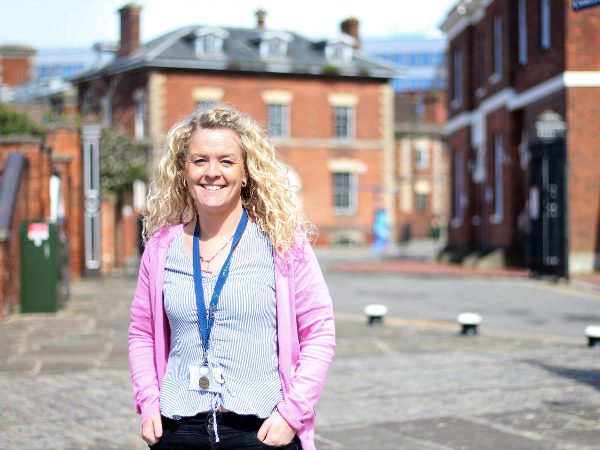
Youth and Community Worker, Hanne Arts talks about the steps to take, in order to move out of your comfort zone and make changes in your life.
3 January 2022
Young people that come to YG often want to make a change in their lives and what better time to start than the New Year.
In order to make change we often need to break away from old habits that are holding us back. But it is these familiarities that often make us feel safe. It is this safety net, our comfort zone, which helps us to feel secure while also holding us back from change.
At YG we challenge young people every day, to try new things and confront their fears. Whether that’s through work experience, rock climbing or speaking with a counsellor. But change is not easy. Youth and Community Worker, Hanne Arts talks about how she works with young people and the steps she encourages them to take in order to move out of their comfort zones and make changes to the lives.
“In part of my role I do one-to-one work with young people struggling with eating disorders. The two questions that come up most frequently are:
- What will happen if I never give up my eating disorder?
- What will happen if I do?
The first one is easy to answer: keep doing what you’re already doing… and nothing will change. I tell them, frankly, that they will continue feeling unwell, unconfident, and unsatisfied. They will never reach their moving target ‘goal weight’ and they will never truly live.
“The second question is harder to answer: you’ll only know what change will bring once you embrace this change with open arms. The eating disorder is ‘easy’ – it’s a crutch, a way out, and it will always be there. It is harder to choose recovery, to choose change, but it is only by choosing recovery that you realise how worthwhile it is. They must dare to take that step outside their comfort zone. To find out for themselves why it is so worthwhile.
“It is true for all change, whether that’s giving up smoking, finding a new job, overcoming fears or feeling more fulfilled – you can get there. But you have to believe in yourself and be brave enough to take that first step in the right direction. Perhaps with the New Year you are thinking about changes you want to make to your lifestyle. I know, putting change into practice is not quite as simple as it sounds. But here at YG we are ready to help you and here are some tools that may start you off in the right direction.
Step 1: Define your comfort zone
To step outside your comfort zone, you must first become aware of what is already inside and what is currently outside of your comfort zone. Consider your goals and see what steps you are already taking to reach them. Then, consider what steps currently remain out of reach. Define your comforts and discomforts so you know what is holding you back. This is your starting point.
Step 2: Define the discomforts you want to challenge
Now look deeper into these ‘discomforts’. Consider:
- What is causing the discomfort?
- What thoughts are encouraging your fears?
- What experiences prove or disprove the rationale behind your discomfort?
Step 3: Get comfortable with the discomfort
You may not have any experience that prove or disprove your underlying thoughts and feelings, so go ahead and put them to the test. The best way to get comfortable with the things outside your comfort zone is by expanding the boundaries of this comfort zone. Make it a goal to challenge your fears and your discomforts. Make it into a game to challenge your preconceptions. If you challenge your fears, you will find out through experience that it isn’t so bad, and, with repeated exposure, that it gets easier and easier. So tackle your fears and keep tackling them. It gets better.
Step 4: Take baby-steps
Tackle your fears, but don’t tackle them all at once. In other words, don’t bite off more than you can chew! In eating disorder recovery, biting off more than one can chew often looks like accepting a full recovery meal plan, freaking out, and then not eating at all for several days to compensate and reduce the anxiety – one leap forward and two steps back. Don’t overwhelm yourself, take things slowly and focus on gradual change. As long as you keep moving forward, you will get there in the end. Have patience; keep going.
Step 5: And if you do fail…
If you do fall down, or if an experience actually is as bad as you feared… well, see it as a learning experience. Determine what went wrong, adapt your tactics and go again. Take what you have learned and go again. You are also bound to find out, even failure isn’t as bad as you may have feared! Get up, move on and reach for your goals.
Step 6: Keep up the positive self-talk
Throughout it all, pat yourself on the back. What you are doing requires courage and you are doing well! Remind yourself of that and be proud of your achievements. Sometimes, positive self-talk and visualisations are a first step in your gradual journey, so don’t overlook this and be kind to yourself. I believe that you can do whatever you put your mind to – now believe in yourself too!”
If you would like support from a YG Youth Worker like Hanne to help you make positive changes in your life, take a look at our chat services and see if this kind of support might help you.
You may also like...
Redesigning Graphic House: Creating the safe spaces young people deserve

Meet Jamie – Learning, growing, and giving back through Youth Work

From Probable Mental Illness to Wellness

Young Gloucestershire’s ED and I journey

